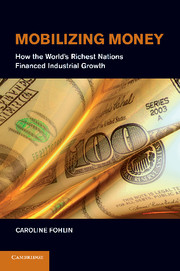Book contents
6 - Classifying Financial Systems
Published online by Cambridge University Press: 05 January 2012
Summary
Financial systems have evolved along different paths in different places around the world and over time, raising the question of whether some systems have performed consistently better than others. Before we can consider the relationship between financial system design and economic performance, we must understand how actual financial systems are structured, or were in the past. In particular, it would be helpful to be able to divide up the world’s systems into a small number of categories, so we could use those categories as a quantifiable measure in explaining desirable outcomes such as economic growth.
Classification of financial systems typically follows a binary approach, and most often focuses on the relative dependence of corporate finance on capital markets or banks: A system is either bank-based or market-based. This system dichotomy has tended to subsume other institutional features that characterize banks and financial systems, such as scope of banking services (universality), engagement in relationship banking, corporate governance mechanisms, markets for corporate control, or capital structure of corporate firms.
Information
- Type
- Chapter
- Information
- Mobilizing MoneyHow the World's Richest Nations Financed Industrial Growth, pp. 139 - 165Publisher: Cambridge University PressPrint publication year: 2011
